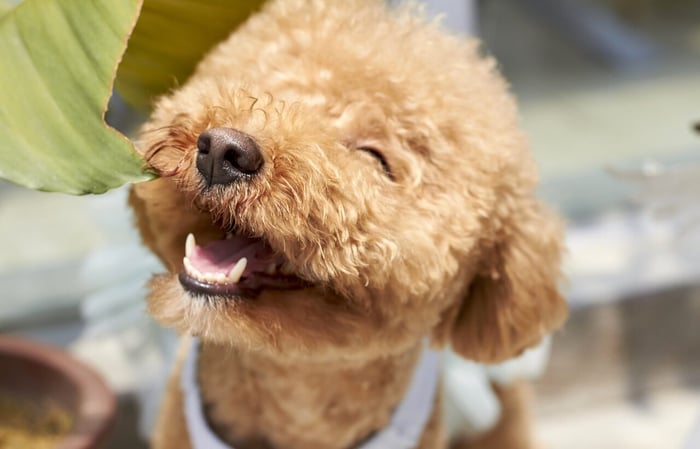The Beagle, oh, the Beagle! Doesn't just hearing the word conjure up pictures of those floppy ears, impish eyes, and ever-curious nose? If you've ever met a Beagle, you'll know that it doesn't just walk; it sniffs, wags, and gleefully trots its way into your heart. Dive into the vibrant tapestry of this breed's features as a potential Beagle parent or an enthusiast wanting to learn more. While it's tempting to judge this book only on its lovely cover, there's a lot more going on beyond the surface.
The Beagle story goes much beyond Snoopy's renowned antics in the "Peanuts" comic strip. Behind their deep eyes is hundreds of years of history, evolution, and a symphony of characteristics that make this breed so lovable. So, what's the deal with the Beagle's soaring popularity? So, how about we sniff out the specifics together?
Origin and History of the Beagle Breed
The origins of the Beagle trace back centuries, with early versions of the breed appearing in England as far back as the 1300s. It’s believed that the word "Beagle" comes from the Gaelic word "beag," meaning small—an apt name for these compact, energetic hounds. Originally developed by English gentlemen for hunting rabbits and small game, the Beagle was bred to be both determined and agile in the field.
The modern day Beagle owes much of its development to selective breeding in the 19th century, particularly by responsible breeders who aimed to refine the breed’s scenting abilities and temperament. Beagles became especially popular with hunters who valued their endurance and pack compatibility. Over time, their friendly disposition and lovable charm made them ideal family dogs, not just skilled retriever or scent hounds.
The American Kennel Club officially recognized the Beagle in 1885, and today, they’re regularly featured in dog shows and celebrated by breed organizations like the National Beagle Club. Many beagles named for their achievements in both field and show ring have helped cement the breed’s legacy.
From loyal hunting companions to cherished pets in popular culture, Beagles continue to win hearts across the U.S. Their heritage as hardworking, intelligent dogs with a compelling scent drive is still evident in their behavior today—making them one of the most iconic and enduring breeds among other dogs and other breeds alike.

Physical Characteristics of the Beagle
The Beagle is a beloved breed, famously recognized by the American Kennel Club as one of the best scent hounds. Known for their distinctive appearance, Beagles are typically classified among smaller hounds, standing up to 15 inches at the shoulder. Most adult Beagle dogs weigh between 20 to 30 pounds, though Beagle pups tend to grow quickly into sturdy healthy dogs.
Their charming appearance includes an adorable face, large expressive eyes, and famously long, velvety soft ears that are prone to ear infections without proper care. This healthy breed boasts a dense double coat, perfect for outdoor adventures such as hunting rabbits or simply playing outside with other dogs or other pets.
Unlike larger hounds or larger dog breeds, the modern-day Beagle maintains a compact build ideal for families living in various settings, whether rural or urban. Their appealing looks and manageable size have made Beagles popular among English gentlemen in historical England and widely favored in American households today.
Responsible owners and responsible breeders, including those affiliated with the National Beagle Club, recommend regular grooming to maintain their coat and health checks with a trusted vet. Beagles are known to experience certain health issues such as hip dysplasia, luxating patella, eye disorders, and weight gain if not provided proper nutrition through quality dog food and balanced treats.
Renowned as good family dogs, Beagles are famously sociable and enjoy company from both people and other breeds. However, their compelling curiosity and remarkable sense of smell can occasionally make them escape artists when off a leash or left unattended. Positive training, daily regular exercise (at least an hour), and engaging activities help manage these instincts, keeping your pup safe and happy.
Overall, whether you're considering a puppy or an adult Beagle, their charming looks, friendly temperament, and manageable size make them delightful companions and loyal members of the family.
Temperament and Personality of Energetic Dogs
The Beagle is known not only for its keen sense of smell but also for its lively and affectionate nature. As one of the most energetic dogs in the hound group, the modern breed has a spirited personality that makes it both entertaining and lovable.
Social and Affectionate
Beagle dogs are incredibly social and thrive in households with other pets or other dogs. Their strong pack mentality comes from generations of hunting small game alongside larger hounds, which makes them crave companionship. Whether it's people, other animals, or Beagle puppies, they bond quickly and enjoy being part of the action.
Because of this, they may experience separation anxiety when left alone too long. A good way to help is by offering plenty of playtime, mental stimulation, and comfort items like toys or tasty treats—especially those designed for food motivated breeds.
Cute Duck Plush Toy With Squeaker Dog Chew Toy

$9.99
Give your friend joy with our Cute Duck Plush Toy With Squeaker. This delightful dog chew toy is designed to entertain and captivate dogs of all sizes. Charming Duck Design: The plush toys cute duck design is sure to charm… read more
Vocal and Expressive
Often called “singing Beagles” due to their vocal nature, they use barking, baying, and howling to communicate excitement or follow an interesting scent. While charming to fans of the breed, it's something potential owners should be ready for—especially in apartment settings.
Intelligent but Stubborn
Beagles are among the most intelligent dogs in terms of scent tracking, but that doesn't always translate to obedience. Their strong hunting instinct can make them easily distracted, especially during training sessions. Early socialization and consistent positive reinforcement are key.
Using rewards and training tools designed for active dogs can make a huge difference. Keep sessions fun, short, and rewarding—with plenty of dog food rewards—to match their playful, independent spirit.
Great Family Pets
Beagles are naturally gentle and loving, making them ideal family pets. Their playful nature means they get along well with children and are adaptable to both city and country living—just as long as they get at least an hour of exercise and attention each day.

Training and Socialization of Beagle Puppies
Training Beagle puppies can be a rewarding experience—but it does come with unique challenges. As one of the most intelligent dogs in terms of scent work, the Beagle is quick to learn but often ruled by its nose. Their strong hunting instincts and independent nature mean consistent, positive reinforcement is essential from a young age.
Early socialization is crucial for Beagle puppies. Exposing them to other dogs, other pets, and a variety of environments helps build confidence and reduces unwanted behaviors later in life. A well-socialized Beagle dog is more likely to become a calm, friendly family pet, especially in multi-pet households.
Introduce them gradually to:
New people and children
Different sounds, textures, and environments
Walks with other animals or energetic breeds
Group play or puppy classes through reputable breeders or trainers
Use Motivation-Based Training
Because Beagles are food motivated, they respond exceptionally well to treat-based training. Keep sessions fun and focused with tasty treats, praise, and short commands. Avoid punishment-based approaches—they're more likely to ignore than engage.
Training tools like puzzle feeders, scent games, or basic agility courses provide both mental stimulation and a healthy outlet for their energy. Always end on a positive note to build trust and engagement.
Be Patient and Consistent
Due to their natural independence and sense of smell, Beagles can become distracted—especially when following an interesting scent. To keep their attention:
Practice training in low-distraction environments at first
Use a clicker or marker word to reinforce correct behavior
Stick to short, consistent sessions for the best results
Preparing for Life as an Energetic Adult
Most Beagles grow into active, curious adults who thrive with structured routines and regular exercise. Building those habits during the puppy stage sets the foundation for a well-behaved, confident dog.
Whether your pup comes from responsible breeders or a rescue, early training is the key to unlocking the best in this modern breed.

Health and Dog's Diet Needs for Beagles
The Beagle is a generally healthy and resilient dog breed, but like all energetic dogs, they have some breed-specific health considerations. Maintaining their health requires proper dog food, regular exercise, and routine vet visits.
Common Beagle Health Concerns
Although many Beagles live long, active lives, there are a few health conditions that can affect them:
Hip Dysplasia – A genetic condition that affects the hip joint. While it's more common in larger hounds, some affected dogs may show signs of stiffness or difficulty with movement.
Ear Infections – Their long floppy ears and soft ears can trap moisture and dirt, making regular cleaning essential to prevent infection.
Obesity – Because Beagles are food motivated, they're at high risk for weight gain. Keeping them at a healthy weight helps reduce strain on joints and internal organs.
Hypothyroidism – Issues with the thyroid gland can lead to weight gain, lethargy, and skin conditions.
Allergies (Beagles) – Skin sensitivities and food allergies can affect some Beagles. Watch for itching, ear redness, or gastrointestinal issues.
Partnering with your vet for routine exams and preventative care is the best way to detect and manage these conditions early.
Choosing the Right Dog Food for Beagles
Because of their strong hunting instinct and high activity levels, Beagles need a balanced diet that supports both energy and muscle health. Look for dog food that includes:
High-quality protein for lean muscle
Omega fatty acids for skin and coat health
Fiber to aid digestion and prevent bloating
Joint support ingredients (like glucosamine) for breeds prone to hip dysplasia
Portion control is also key—not all Beagles know when to stop eating! Consider using slow-feeder bowls or puzzle feeders to help with portion control while adding mental stimulation.
Healthy Habits for a Healthy Beagle
Keep a routine of regular nail trimming to prevent posture issues
Brush with a medium bristle brush or hound glove weekly to promote new hair growth and reduce shedding
Make sure your Beagle gets at least an hour of physical activity daily
Use treats in moderation—especially tasty treats designed for training or low-calorie snacks
A healthy diet and lifestyle not only reduce health risks—they also keep your Beagle happy, fit, and ready for any adventure, whether it's hunting rabbits or chasing squirrels in the backyard.
Conclusion
Beagles are lively, affectionate, and loyal dogs that bring endless joy to their families. Whether you're drawn to their friendly nature or their energetic spirit, a Beagle can be the perfect addition to your home. Just make sure you're ready for their playful personality and high energy levels, as they love staying active. Providing them with a fenced-in yard, regular walks, and a durable chew toy can help keep them happily occupied and healthy. With the right environment and plenty of playtime, a Beagle will thrive.
For those considering bringing a Beagle into their lives, be prepared for a rollercoaster of love and laughter. From their curious sniffs to their wagging tails, these dogs have a way of leaving a lasting paw print on your heart.
Reference:











